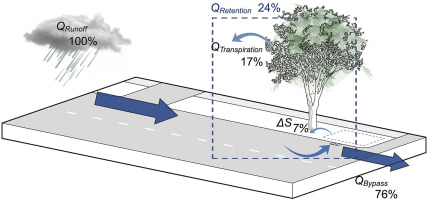当前位置:
X-MOL 学术
›
Water Res.
›
论文详情
Our official English website, www.x-mol.net, welcomes your
feedback! (Note: you will need to create a separate account there.)
Transpiration by established trees could increase the efficiency of stormwater control measures.
Water Research ( IF 11.4 ) Pub Date : 2020-02-08 , DOI: 10.1016/j.watres.2020.115597 Jasmine K Thom 1 , Christopher Szota 1 , Andrew M Coutts 2 , Tim D Fletcher 1 , Stephen J Livesley 1
Water Research ( IF 11.4 ) Pub Date : 2020-02-08 , DOI: 10.1016/j.watres.2020.115597 Jasmine K Thom 1 , Christopher Szota 1 , Andrew M Coutts 2 , Tim D Fletcher 1 , Stephen J Livesley 1
Affiliation

|
Evapotranspiration is an important aspect of the hydrological cycle in natural landscapes. In cities, evapotranspiration is typically limited by reduced vegetation and extensive impervious surfaces. Stormwater control measures (SCMs) seek, among other objectives, to move the urban hydrological cycle towards pre-development conditions, promoting processes such as infiltration and evapotranspiration. Yet, evapotranspiration is generally assumed to play a minor role in the water balance of stormwater control measures. Since established urban trees can use large quantities of water, their inclusion with stormwater control measures could potentially substantially increase evapotranspiration. We installed infiltration trenches alongside established Lophostemon confertus trees in the grassed verges of a typical suburban street to assess 1) whether redirecting stormwater to trees could increase their transpiration and 2) the contribution of transpiration to the water balance of stormwater control measures. We measured stormwater retention and transpiration for two spring-summer periods and estimated an annual water balance for the infiltration trenches. Although redirecting stormwater to trees did not increase their transpiration, these trees did use large volumes of water (up to 96 L d-1), corresponding to 3.4 mm d-1 per projected canopy area. Annually, stormwater retention was 24% of runoff and tree transpiration was equivalent to 17% of runoff. Our results suggest that streetscapes fitted with tree-based stormwater control measures, could increase the volumetric reduction of stormwater runoff by increasing the proportion of evapotranspiration in the water balance. Since public space is highly contested in cities and increasing canopy cover is a priority for many planners, integrating trees with stormwater control measures could provide dual benefits for a single management intervention, enabling a greater number of distributed stormwater control measures with smaller impervious catchments in the streetscape.
中文翻译:

成熟树木的蒸腾作用可以提高防雨措施的效率。
蒸散是自然景观中水文循环的重要方面。在城市中,蒸散通常受到植被减少和不透水面的限制。除其他目标外,雨水控制措施(SCM)力求将城市水文循环推向发展前的条件,促进入渗和蒸散等过程。然而,通常认为蒸散量在雨水控制措施的水平衡中仅扮演很小的角色。由于成熟的城市树木会消耗大量的水,因此将其纳入雨水控制措施可能会大大增加蒸散量。我们在一条典型的郊区街道的草丛中,在既有的Lophostemon confertus树旁边安装了渗水沟,以评估1)将雨水重新引入树木是否可以增加其蒸腾作用,以及2)蒸腾作用对雨水控制措施水平衡的贡献。我们测量了两个春夏时期的雨水滞留和蒸腾作用,并估算了渗入沟渠的年度水平衡。尽管将雨水重定向到树木并没有增加蒸腾作用,但这些树木确实使用了大量的水(高达96 L d-1),相当于每个预计的冠层面积为3.4 mm d-1。每年,雨水截留量占径流量的24%,树木的蒸腾量相当于径流量的17%。我们的结果表明,街景采用了基于树的雨水控制措施,通过增加水量平衡中的蒸散量,可以增加雨水径流的体积减少。由于城市中公共空间的竞争非常激烈,而增加雨棚的覆盖范围是许多规划人员的当务之急,因此,将树木与雨水控制措施相结合可以为单一管理干预措施带来双重好处,从而实现了更多的分布式雨水控制措施,而防洪集水区却较小。街景。
更新日期:2020-02-10
中文翻译:

成熟树木的蒸腾作用可以提高防雨措施的效率。
蒸散是自然景观中水文循环的重要方面。在城市中,蒸散通常受到植被减少和不透水面的限制。除其他目标外,雨水控制措施(SCM)力求将城市水文循环推向发展前的条件,促进入渗和蒸散等过程。然而,通常认为蒸散量在雨水控制措施的水平衡中仅扮演很小的角色。由于成熟的城市树木会消耗大量的水,因此将其纳入雨水控制措施可能会大大增加蒸散量。我们在一条典型的郊区街道的草丛中,在既有的Lophostemon confertus树旁边安装了渗水沟,以评估1)将雨水重新引入树木是否可以增加其蒸腾作用,以及2)蒸腾作用对雨水控制措施水平衡的贡献。我们测量了两个春夏时期的雨水滞留和蒸腾作用,并估算了渗入沟渠的年度水平衡。尽管将雨水重定向到树木并没有增加蒸腾作用,但这些树木确实使用了大量的水(高达96 L d-1),相当于每个预计的冠层面积为3.4 mm d-1。每年,雨水截留量占径流量的24%,树木的蒸腾量相当于径流量的17%。我们的结果表明,街景采用了基于树的雨水控制措施,通过增加水量平衡中的蒸散量,可以增加雨水径流的体积减少。由于城市中公共空间的竞争非常激烈,而增加雨棚的覆盖范围是许多规划人员的当务之急,因此,将树木与雨水控制措施相结合可以为单一管理干预措施带来双重好处,从而实现了更多的分布式雨水控制措施,而防洪集水区却较小。街景。











































 京公网安备 11010802027423号
京公网安备 11010802027423号